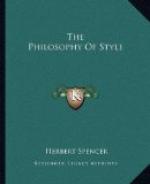51. Hence, then, the higher forms of speech acquire a secondary strength from association. Having, in actual life, habitually heard them in connection with vivid mental impressions, and having been accustomed to meet with them in the most powerful writing, they come to have in themselves a species of force. The emotions that have from time to time been produced by the strong thoughts wrapped up in these forms, are partially aroused by the forms themselves. They create a certain degree of animation; they induce a preparatory sympathy, and when the striking ideas looked for are reached, they are the more vividly realized.
52. The continuous use of these modes of expression that are alike forcible in themselves and forcible from their associations, produces the peculiarly impressive species of composition which we call poetry. Poetry, we shall find, habitually adopts those symbols of thought, and those methods of using them, which instinct and analysis agree in choosing as most effective, and becomes poetry by virtue of doing this. On turning back to the various specimens that have been quoted, it will be seen that the direct or inverted form of sentence predominates in them; and that to a degree quite inadmissible in prose. And not only in the frequency, but in what is termed the violence of the inversions, will this distinction be remarked. In the abundant use of figures, again, we may recognize the same truth. Metaphors, similes, hyperboles, and personifications, are the poet’s colours, which he has liberty to employ almost without limit.




